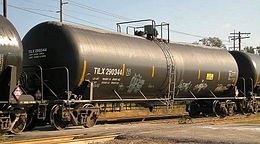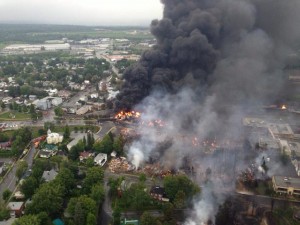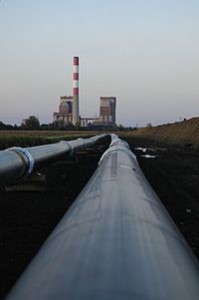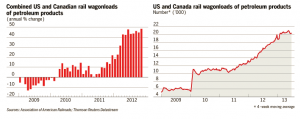
Lac-Mégantic Disaster Shines Light On North American Oil Transport
 The small town of Lac-Mégantic, Quebec was rocked early Saturday morning by a series of massive explosions—Canadian Prime Minister Stephen Harper likened it to a “war zone.”
The small town of Lac-Mégantic, Quebec was rocked early Saturday morning by a series of massive explosions—Canadian Prime Minister Stephen Harper likened it to a “war zone.”
Sometime shortly after 1:00AM, a train carrying 73 tanker cars (almost 50,000 barrels) of Bakken-sourced crude oil derailed in the center of town. The resultant explosions and fire decimated the downtown core. As of now, there are thirteen confirmed deaths and fifty officially missing persons; however, those numbers are likely to rise.
There is still speculation as to the exact cause of this tragedy, but what is known is that the train was stopped at a rail yard in Nantes, 6.8km southeast of Lac-Mégantic. At approximately 11:25PM the conductor and crew parked the engine and left the train unattended as part of a routine shift-change. Somehow, the cars became uncoupled from the engines and their brakes failed. This allowed them to roll backwards toward Lac-Mégantic, gaining considerable speed before derailing.
While Lac-Mégantic is still considered a crime scene by local police, this tragedy has served as a poignant reminder of how we transport oil across the continent.
Massive increases in North American oil production from both American shale and Canadian oil sands have put tremendous strain on existing infrastructure. Pipelines have long lead-times and are politically difficult to build; the Obama Administration is still dragging its feet on Keystone XL and, in May, the province of British Columbia formally rejected the Northern Gateway pipeline that was supposed to transport oil from Alberta to the Pacific.
In light of this, the railway industry has stepped up to transport this surge in supply from the wellhead to the refineries and beyond. Crude shipments by rail, which totaled just 9,500 cars in 2008, are up to 97,000 cars in the first quarter of 2013 alone. This is expected to increase almost 40-fold in the next five years
Some predicted this shift and, in a typically clairvoyant manner, Warren Buffet’s Berkshire Hathaway purchased Burlington Northern Santa Fe, a Texas-based railroad company, in 2009. Buffet bluntly described this purchase as an “all-in wager on the economic future of the United States,” and it seems to be paying off. Revenues of the seven largest freight railways are up over 40% since 2009, and investors are seeing an average 11.1% return on equity.
While railways are certainly a good investment at present, some question their safety relative to pipelines.
 A recent report by Manhattan Institute argues that pipelines are, by far, the safest way to transport oil. The report compares pipeline incidents, which average 0.0068 per billion ton-miles, to rail, which averages almost forty times more incidents at 0.2594/billion ton-miles. The report also concludes that both are considerably safer than transport by truck.
A recent report by Manhattan Institute argues that pipelines are, by far, the safest way to transport oil. The report compares pipeline incidents, which average 0.0068 per billion ton-miles, to rail, which averages almost forty times more incidents at 0.2594/billion ton-miles. The report also concludes that both are considerably safer than transport by truck.
The report focuses primarily on injury-related incidents, however, and spends little more than a paragraph discussing how spill-rates compare between the two transportation methods. While fewer injuries occur when oil is transported by pipeline, spills are more than twice as common. Between 2002 and 2012, the spill-rate (measured as gallons spilled per million barrel miles) was 0.38 for rail compared to 0.88 for pipelines.
Much of the debate surrounding North American oil production has centered on the negative effects of hydraulic fracturing and the oil sands’ incredible carbon footprint. However, in a world of high oil prices, these resources are going to be developed, and domestic support continues to outweigh opposition. We need to shift our focus, and begin weighing the costs and benefits of different transportation methods in order to arrive at effective policy.
Pipelines are more cost effective in the long run, but require heavy initial capital investment and are more prone to spills. Rail networks exist now, but are more expensive and transport hazardous materials close to—or through—population centers.
 Transporting oil is never going to be 100% safe, but technologies exist that can lower the probability of incident. Industry needs a push to adopt these technologies, however, as many are still avoiding the heavier initial cost and opting, instead, for older, cheaper technology.
Transporting oil is never going to be 100% safe, but technologies exist that can lower the probability of incident. Industry needs a push to adopt these technologies, however, as many are still avoiding the heavier initial cost and opting, instead, for older, cheaper technology.
For instance, it was recently announced that TransCanada Corp., the firm behind Keystone XL, is not going to include state-of-the-art detection technology in its 3,200km pipeline. These technologies include innovations like infrared imaging and acoustic detectors that are much better at detecting smaller leaks that would normally go unnoticed. Government can play an integral role by mandating that new pipelines include the newest spill-prevention technologies.
While a carbon-free economy is the ultimate desirable future, this transition will likely come to transportation slower than it will to electricity production. In the meantime, we will still require oil for all manner of personal and industrial transport. We need to begin having a serious public conversation about the way we transport oil across the continent—we must ensure that if this oil must be transported, it is done so in the safest manner possible.
Rory Johnston is a Master of Global Affairs (MGA) candidate at the University of Toronto’s Munk School of Global Affairs with a focus on energy markets and security.







[…] three times as much crude oil as trains over comparative distances. Seconding this point, an American Security Project analysis of this same subject notes: While fewer injuries occur when oil is transported by pipeline, spills […]
[…] between rail and pipeline transportation is relatively new. However, most evidence thus far has found that pipelines are safer but have a higher leak-rate than rail. On top of the safety record, one […]